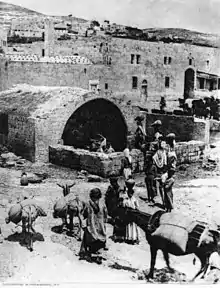Return of the family of Jesus to Nazareth
The return of the family of Jesus to Nazareth, also known as the Return from Egypt, appears in the reports of the early life of Jesus given in the Canonical gospels. Both of the gospels which describe the nativity of Jesus agree that he was born in Bethlehem and then later moved with his family to live in Nazareth. The Gospel of Matthew describes how Joseph, Mary, and Jesus went to Egypt to escape from Herod the Great's slaughter of the baby boys in Bethlehem. Matthew does not mention Nazareth as being the previous home of Joseph and Mary; he says that Joseph was afraid to go to Judea because Herod Archelaus was ruling there and so the family went to Nazareth instead.[1][2][3] The Gospel of Luke, on the other hand, does not record anything about the flight to Egypt, but says that Joseph had been previously living in Nazareth,[4] and returned there after the Presentation of Jesus at the Temple.[5]
_-_James_Tissot_-_overall.jpg.webp)
| Events in the |
| Life of Jesus according to the canonical gospels |
|---|
 |
|
Portals: |
Return from Egypt

Sometime after Herod had died, the holy family returns from Egypt. Most scholarship places the date of Herod's death around 4 BCE.[6][7][8]
Upon learning that Herod Archelaus had succeeded his father in Judea, they continued on to Galilee. Archelaus was known for his cruelty and in response to complaints from the populace, in 6 AD he was deposed by Augustus and banished to Vienne in Gaul. Galilee was ruled by Archelaus's brother, Herod Antipas.
Significance

In Matthew 2:23, the return to Nazareth is said to be a fulfilment of the prophetic word, "He shall be called a Nazarene". It is not clear which Old Testament verse Matthew might have had in mind; many commentators suggest it is Isaiah 11:1, where it says "A shoot will come up from the stump of Jesse; from his roots a Branch will bear fruit" (NIV): the Hebrew word for "branch" is nezer.[9][10]
Art
The family's return journey from Egypt has frequently been a subject of artistic representation.
Commentary
Some Bible scholars had noted differences in the birth narrative story of the flight. Raymond E. Brown claimed that the narratives are "...contrary to each other in a number of details."[11]
See also
References
- Matthew 2:22
- Bart D. Ehrman, Jesus: apocalyptic prophet of the new millennium, Oxford University Press 1999, page 38; Paula Fredriksen, From Jesus to Christ (Second edition, Yale University Press, 2000, page 36); R. T. France, The Gospel of Matthew (Wm. B. Eerdmans Publishing, 2007) page 43; Rudolf Schnackenburg, The Gospel of Matthew, (Wm. B. Eerdmans Publishing, 2002) page 27; Marcus Borg, 'The Meaning of the birth stories', in Borg and Wright, The Meaning of Jesus: Two Visions (HarperOne, 1999), page 180.
- "The Persecuted Child". Bible Gateway. Retrieved 29 November 2016.
- Luke 2:4
- Luke 2:39
- Schürer, Emil. A History of the Jewish People in the Time of Jesus Christ, 5 vols. New York, Scribner's, 1896.
- Barnes, Timothy David. "The Date of Herod's Death," Journal of Theological Studies ns 19 (1968), 204–219
- Bernegger, P. M. "Affirmation of Herod's Death in 4 B.C.", Journal of Theological Studies ns 34 (1983), 526–531.
- Keener, Craig (2009). The Gospel of Matthew: A Socio-Rhetorical Commentary. Eerdmans. p. 114. ISBN 9780802864987. Retrieved 28 November 2016.
- IVP New Testament Commentaries, Growing Up in a Small Town, accessed 29 November 2016
- Brown, Raymond E., The Birth of the Messiah, Yale University Press, 1999, p. 36ISBN 9780300140088
Return of the family of Jesus to Nazareth | ||
| Preceded by Massacre of the Innocents |
New Testament Events |
Succeeded by Finding Jesus in the Temple |
| Wikimedia Commons has media related to House of Nazareth. |